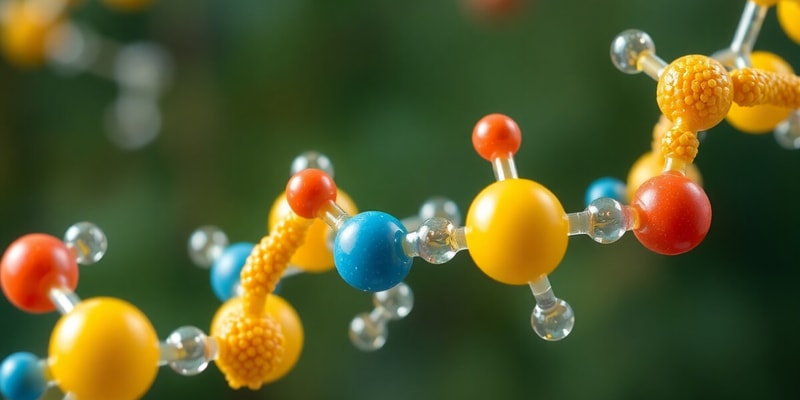Podcast
Questions and Answers
What property of carbon allows it to form diverse organic compounds?
What property of carbon allows it to form diverse organic compounds?
Which statement correctly describes isomers?
Which statement correctly describes isomers?
What role do hydrophilic functional groups play in organic molecules?
What role do hydrophilic functional groups play in organic molecules?
How do testosterone and estradiol differ from each other?
How do testosterone and estradiol differ from each other?
Signup and view all the answers
What constitutes macromolecules in biological systems?
What constitutes macromolecules in biological systems?
Signup and view all the answers
Which phrase best describes hydrocarbons?
Which phrase best describes hydrocarbons?
Signup and view all the answers
What is primarily responsible for the diverse properties of organic compounds?
What is primarily responsible for the diverse properties of organic compounds?
Signup and view all the answers
Which statement about the four classes of biological molecules is true?
Which statement about the four classes of biological molecules is true?
Signup and view all the answers
What process is involved in linking amino acids to form a polypeptide?
What process is involved in linking amino acids to form a polypeptide?
Signup and view all the answers
Which level of protein structure is characterized by the sequence of amino acids?
Which level of protein structure is characterized by the sequence of amino acids?
Signup and view all the answers
What stabilizes the secondary structure of proteins?
What stabilizes the secondary structure of proteins?
Signup and view all the answers
What term describes proteins formed from more than one polypeptide chain?
What term describes proteins formed from more than one polypeptide chain?
Signup and view all the answers
Which component is NOT part of a nucleotide?
Which component is NOT part of a nucleotide?
Signup and view all the answers
What structural form does DNA take?
What structural form does DNA take?
Signup and view all the answers
Which molecule serves as the blueprint for proteins?
Which molecule serves as the blueprint for proteins?
Signup and view all the answers
What distinguishes the 20 different amino acids?
What distinguishes the 20 different amino acids?
Signup and view all the answers
What type of polysaccharide is cellulose classified as?
What type of polysaccharide is cellulose classified as?
Signup and view all the answers
Which statement best describes saturated fatty acids?
Which statement best describes saturated fatty acids?
Signup and view all the answers
What are trans fats primarily formed from?
What are trans fats primarily formed from?
Signup and view all the answers
What health risks are associated with trans fats according to the scientific studies mentioned?
What health risks are associated with trans fats according to the scientific studies mentioned?
Signup and view all the answers
What is the primary composition of lipids?
What is the primary composition of lipids?
Signup and view all the answers
What is the typical state of unsaturated fatty acids at room temperature?
What is the typical state of unsaturated fatty acids at room temperature?
Signup and view all the answers
What distinguishes hydrogenated oils from other oils?
What distinguishes hydrogenated oils from other oils?
Signup and view all the answers
Which type of fats typically contains one or more double bonds?
Which type of fats typically contains one or more double bonds?
Signup and view all the answers
What is the main consequence of disseminating or selling parts of this work?
What is the main consequence of disseminating or selling parts of this work?
Signup and view all the answers
Who is primarily allowed to distribute the materials from this work?
Who is primarily allowed to distribute the materials from this work?
Signup and view all the answers
What do all recipients of this work need to adhere to?
What do all recipients of this work need to adhere to?
Signup and view all the answers
Which of the following statements best reflects the copyright policy for this work?
Which of the following statements best reflects the copyright policy for this work?
Signup and view all the answers
What is implied about the integrity of the work if it is improperly shared?
What is implied about the integrity of the work if it is improperly shared?
Signup and view all the answers
What role do mutations in DNA play in the evolution of lactose tolerance among human populations?
What role do mutations in DNA play in the evolution of lactose tolerance among human populations?
Signup and view all the answers
Which of the following groups is highlighted in research regarding lactose tolerance evolution?
Which of the following groups is highlighted in research regarding lactose tolerance evolution?
Signup and view all the answers
What is a significant factor in the development of lactose tolerance in certain human populations?
What is a significant factor in the development of lactose tolerance in certain human populations?
Signup and view all the answers
How is lactose tolerance linked to human evolution?
How is lactose tolerance linked to human evolution?
Signup and view all the answers
What is the significance of the lactase gene in populations that have developed lactose tolerance?
What is the significance of the lactase gene in populations that have developed lactose tolerance?
Signup and view all the answers
Which of the following best describes lactose in dietary terms?
Which of the following best describes lactose in dietary terms?
Signup and view all the answers
What kind of evidence suggests that trans fats are more unhealthy than saturated fats?
What kind of evidence suggests that trans fats are more unhealthy than saturated fats?
Signup and view all the answers
Which chemical group is crucial for understanding biological molecules involved in lactose digestion?
Which chemical group is crucial for understanding biological molecules involved in lactose digestion?
Signup and view all the answers
What process is used to link monomers together to form polymers?
What process is used to link monomers together to form polymers?
Signup and view all the answers
Which statement about monosaccharides is true?
Which statement about monosaccharides is true?
Signup and view all the answers
What is the primary role of enzymes in the context of polymer formation?
What is the primary role of enzymes in the context of polymer formation?
Signup and view all the answers
Which combination of monosaccharides forms the disaccharide lactose?
Which combination of monosaccharides forms the disaccharide lactose?
Signup and view all the answers
What distinguishes a polysaccharide from a monosaccharide?
What distinguishes a polysaccharide from a monosaccharide?
Signup and view all the answers
Which reaction primarily leads to the breakdown of polymers into monomers?
Which reaction primarily leads to the breakdown of polymers into monomers?
Signup and view all the answers
Why are sugars often referred to as 'empty calories' in nutrition?
Why are sugars often referred to as 'empty calories' in nutrition?
Signup and view all the answers
What is the significance of hydroxyl and carbonyl groups in monosaccharides?
What is the significance of hydroxyl and carbonyl groups in monosaccharides?
Signup and view all the answers
Study Notes
Chapter 3: The Molecules of Cells
- Most adults cannot properly digest dairy products due to lactose intolerance, a deficiency in the enzyme lactase.
- Biological molecules like lactase are crucial for daily bodily functions.
- Carbon's ability to bond with four other atoms is the foundation for the complexity of organic compounds.
- Carbon chains form the backbone of most organic molecules.
- Isomers have the same molecular formula but different structures.
- Hydrocarbons are composed solely of carbon and hydrogen.
- Examples of different carbon skeletons include:
- Ethane, Propane
- Butane, Isobutane
- 1-Butene, 2-Butene
- Cyclohexane, Benzene
Isomers
- Structural isomers: Differ in the arrangement of their atoms.
- Geometric isomers: Differ in the spatial arrangement of atoms around a double bond.
- Enantiomers: Mirror images of each other, and they differ in their three-dimensional shape which gives them unique biological activities.
Important Chemical Groups
- An organic compound's properties are determined by the size and shape of its carbon skeleton and the atoms attached to it.
- Hydrophilic functional groups give organic molecules specific chemical properties.
- Table 3.2 illustrates six important chemical groups:
- Hydroxyl
- Carbonyl
- Carboxyl
- Amino
- Phosphate
- Methyl
Sex Hormones
- The sex hormones testosterone and estradiol (a form of estrogen) differ only in the atoms highlighted in Figure 3.2.
Macromolecules
- The four classes of biological molecules contain very large molecules.
- These molecules are called macromolecules because of their large size.
- These molecules are also called polymers because they are made of identical or similar building blocks linked together.
- The building blocks of polymers are called monomers.
Dehydration Synthesis and Hydrolysis
- Monomers are linked together to form polymers through dehydration synthesis (condensation) reactions.
- Polymers are broken apart by hydrolysis.
- Enzymes speed up these reactions.
Carbohydrates
- Carbohydrates range from simple sugar molecules (monomers) to complex polysaccharides.
- Monosaccharides are the simplest sugar monomers.
- A monosaccharide generally has a formula that is a multiple of CH₂O, and contains hydroxyl groups and a carbonyl group.
- Examples of monosaccharides: Glucose and Fructose
- Examples of Disaccharides: Lactose
Polysaccharides
- Starch and glycogen are storage polysaccharides.
- Cellulose is structural and found in plant cell walls.
- Chitin is a structural component of insect and crustacean and fungal cell walls.
Lipids
- Lipids are diverse hydrophobic (water-fearing) compounds composed largely of carbon and hydrogen.
- Fats (triglycerides) consist of glycerol linked to three fatty acids.
- Some fatty acids contain one or more double bonds, forming unsaturated fatty acids which are typical of plant oils.
- Fats with the maximum number of hydrogens are called saturated fatty acids, found in animal fats like butter or lard.
- Hydrogenation converts unsaturated fats into saturated fats, creating trans fats.
Phospholipids and Steroids
- Phospholipids are components of cell membranes.
- Steroids, including cholesterol and some hormones, have a carbon skeleton consisting of four fused rings.
- Cholesterol is a common component in animal cell membranes, and a precursor for other steroids.
Proteins
- Proteins are involved in nearly every dynamic function in the body.
- Proteins function as enzymes, transport, defensive, signal, receptor, contractile and storage proteins.
- Proteins are composed of differing arrangements of 20 amino acid monomers.
- Denaturation is the process where a protein unravels and loses its function.
- Amino acid monomers are linked together in a dehydration reaction, creating a peptide bond.
- R groups distinguish 20 amino acids with specific properties.
- Proteins have four levels of structure: primary, secondary, tertiary, and quaternary.
Nucleic Acids (DNA and RNA)
- The monomers that make up nucleic acids (the blueprint for proteins) are nucleotides.
- Nucleotides consist of a sugar, a phosphate group, and a nitrogenous base.
- DNA is a double helix, while RNA is a single-stranded polynucleotide chain.
- DNA is the molecule of inheritance.
Lactose Tolerance
- Mutations in DNA have led to lactose tolerance in human populations who raised dairy cattle.
- Researchers have identified mutations in East Africa that keep the lactase gene permanently turned on.
Studying That Suits You
Use AI to generate personalized quizzes and flashcards to suit your learning preferences.
Related Documents
Description
This quiz covers key concepts in biology related to organic compounds and macromolecules. You will explore properties of carbon, the nature of isomers, and the roles of functional groups in organic molecules. Additionally, it delves into proteins, nucleotides, and the distinctive features of various biological molecules.




